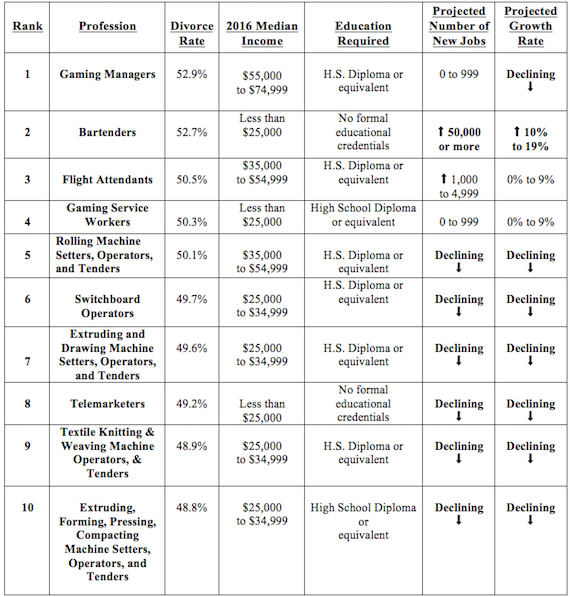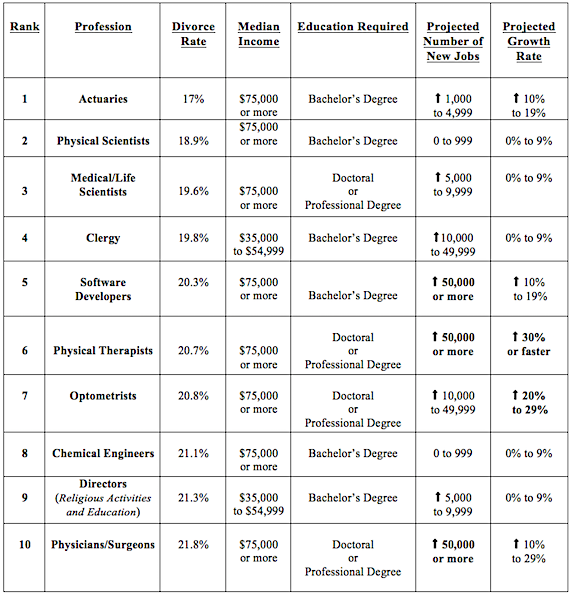Highlights
Editor's Note: The following article was the 10th most popular post on the Family Studies blog in 2017.
A recent report on which occupations have the highest and lowest divorce rates intrigued us. The study analyzed data from the 2015 American Community Survey, and, based on the number of people in a particular occupation who had married at least once, calculated the percentage of people who divorced. We had fun discovering the likelihood of divorce for a variety of occupations: for example, librarians have about a 28% chance of divorce, while phlebotomists have approximately a 46% chance, according to this study.
But as researchers who have looked at the role of economics and race in marriage and divorce, we wanted to see if the data, broken down by occupation, supported other studies on the relationship between money, marriage, and divorce.
People with less income are less likely to be married in the first place, and more likely to be divorced, as a recent IFS study discussed. About 25% of “poor” adults (in households with income below the 20th percentile) aged 18 to 55 are currently married, compared to 39% of working-class adults (in households with income between the 20th and 50th percentiles), and 56% of middle- and upper-class adults (above the 50th percentile). Furthermore, while under one-third of ever-married middle- and upper-class people have ever been divorced, 40% of working-class and poor men and women who have ever been married have also been divorced.
We also know that wealthier people report being happier in their marriages than low-income individuals: as Bloomberg recently reported, 53% of those who describe themselves as lower class rate themselves as happy in marriage, compared to 70% of those who rate themselves as upper class.
In light of these findings, we decided to dig deeper into the data on divorce and occupation, looking at the minimum education level and the median income for the 10 occupations most and least likely to have high divorce rates. We were also intrigued by the outlook for job growth in each occupation based on a hypothesis about hope—that is, if the individuals expect even more employment opportunities, then a break-up might be even less likely.
What we found, as shown in the following two tables,* is that there is a divorce rate of at least 48.8% in the occupations most likely to experience divorce; the divorce rate is under 22% in the 10 occupations least likely to be subject to divorce. Focusing on what is occurring within each profession, we found that none of the professions with the highest divorce rates require more than a high school diploma, and in 7 of those 10 occupations, the projected number of new jobs is expected to decline. By contrast, each of the 10 occupations with the lowest divorce rates required at least a bachelor’s degree, and all of them had at least a small projected growth rate.
Occupations with the Highest Divorce Rates in the U.S.

Sources: Fessler, Leah, "The occupations with the highest and lowest divorce rates in the US," Quartz, 9/6/17;
U.S. Department of Labor, Bureau of Labor Statistics, Occupational Outlook Handbook, 12/17/15.
Apart from gaming managers (who are the group most likely to divorce) and rolling machine setters, operators, and tenders, the 2016 median income for the occupations with the highest divorce rate was less than $35,000. On the other hand, all of the occupations with the lowest divorce rates, apart from clergy and “directors” (of religious activities and education), had incomes of at least $75,000.
Occupations with the Lowest Divorce Rates in the U.S.

Sources: Fessler, Leah, "The occupations with the highest and lowest divorce rates in the US," Quartz, 9/6/17;
U.S. Department of Labor, Bureau of Labor Statistics, Occupational Outlook Handbook, 12/17/15.
Of course, as responsible researchers, we must note that correlation is not causation. We can’t tell you which bartenders are likely to stay married or divorced, nor give advice on choosing a profession based on the divorce rate. Nor with composite figures like this can we tell you about selection effects: that is, those who choose to become bartenders may be less likely to have stable marriages for reasons other than their choice of profession.
What is striking about these numbers, however, is that the income effects appear to be stronger than differences in the nature of the occupations. Bartenders may be at high risk of divorce in every era; rolling machine setters, operators, and tenders seem to be in the same category today more because of their declining employment prospects than because of increased temptations to stray.
One question that does not command enough attention is why the correlation between relationship stability and employment prospects is so strong. We suspect that employment instability, as opposed to low income per se, may be part of the explanation. For those who are not wealthy, marriage has risks as well as benefits. In the United States, the median working-age household has approximately $5,000 in retirement savings, and more than half of Americans have less than $1,000 in the bank. Commitment to a partner with an unstable income—someone who runs up the credit card bills, incurs large health care expenses, or needs to be bailed out of jail—can diminish family savings. The commitment marriage entails requires a willingness—legally, financially, and emotionally—to share the couples’ joint resources. For couples with unstable finances, this commitment may be a source of peril (Carbone & Cahn, 2018).
We recognize there are no easy policy prescriptions for increasing family stability: the interaction between economic changes and cultural norms is multi-causal, dynamic, and interactive. New research by Melissa Kearney and Riley Wilson shows that this connection is even more complex; increased earnings from fracking booms did not lead to more marriage. We suspect once again that the issue involves not the sheer amount of money, but the degree to which new jobs interact with community norms to promote economic and relationship stability. Indeed, we wonder whether fracking jobs would be close to bar tendering positions in their association with divorce rates. Nonetheless, we should do everything possible to mitigate the negative consequences of economic instability on the family and to cushion the harmful effects of increasing economic inequality on children’s life chances.
Naomi Cahn is the Harold H. Greene Professor of Law at The George Washington University Law School. June Carbone is the Robina Chair of Law, Science, and Technology at the University of Minnesota Law School. *The tables in this article were prepared by George Washington University law student Mohammad A. Zaheerudin.
Editor’s Note: The views and opinions expressed in this article are those of the authors and do not necessarily reflect the official policy or views of the Institute for Family Studies.













